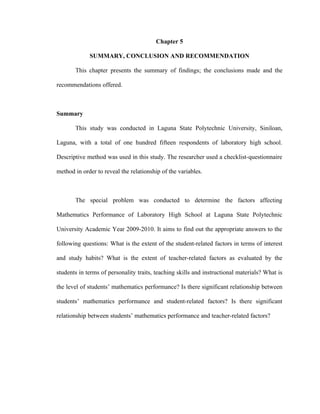
C:\Documents And Settings\All Users\Documents\Chapter 5
- 1. Chapter 5 SUMMARY, CONCLUSION AND RECOMMENDATION This chapter presents the summary of findings; the conclusions made and the recommendations offered. Summary This study was conducted in Laguna State Polytechnic University, Siniloan, Laguna, with a total of one hundred fifteen respondents of laboratory high school. Descriptive method was used in this study. The researcher used a checklist-questionnaire method in order to reveal the relationship of the variables. The special problem was conducted to determine the factors affecting Mathematics Performance of Laboratory High School at Laguna State Polytechnic University Academic Year 2009-2010. It aims to find out the appropriate answers to the following questions: What is the extent of the student-related factors in terms of interest and study habits? What is the extent of teacher-related factors as evaluated by the students in terms of personality traits, teaching skills and instructional materials? What is the level of students’ mathematics performance? Is there significant relationship between students’ mathematics performance and student-related factors? Is there significant relationship between students’ mathematics performance and teacher-related factors?
- 2. Through this problems stated, the researcher came up with the following null hypothesis: Ho There is no significant relationship between the students’ mathematics performance and student-related factors in terms of interest and study habits. Ho There is no significant relationship between students’ mathematics performance and teacher- related factors in terms of personality traits, teaching skills and instructional materials. After administering the questionnaire, the researcher used weighted mean and rank to determine the extent of student-related factors in terms of interest and study habits; and extent of teacher-related factors in terms of personality traits, teaching skills and instructional materials. Mean, median, mode, standard deviation, skewness, kurtosis were used to determine the level of performance of students in Mathematics. And to test the significance of input and output variables, pearson-r were used. Conclusions Based on the data gathered, the overall weighted mean of level of interest in mathematics was 3.90 and interpreted as “often”. Study habits had an average weighted mean of 3.60 and also interpreted as “often”. Personality traits had an average weighted mean of 4.50 and interpreted as “always”. Teaching skills had an average weighted mean of 4.41 and interpreted as “often”. Instructional materials had an average weighted mean of 2.98 and interpreted as “sometimes”.
- 3. In terms of level of performance of the students in mathematics, the students obtained the mean grade of 88.23 with verbal interpretation of “Satisfactory” and standard deviation of 4.84. Through the test of significance, the researcher came up with the following conclusion; there is no significant correlation between student interest in mathematics and their performance in mathematics. Their computed z-value is 0.54 which is less than the tabular z-value of 2.10 at α = .05. There is no significant correlation between study habits and their performance in mathematics. The computed z-value is -0.47 which is less than the tabular z-value of -2.10 at α =0.05. This means that the performance of the students in mathematics does not affected by the student-related factors in terms of interest and study habits. There is no significant relationship between teacher-related factors such as personality traits, teaching skills and instructional materials and the performance of the students in mathematics. Their computed z-values are -0.10, 0.98 and -1.04 which are less than the tabular z-value of -2.10, 2.10 and -2.10 respectively. Thus, teacher-related actors do not affect the performance of the students in mathematics. Recommendations Based on the conclusions made, the following recommendations are given: that a more concentrated research on relationship to Mathematics be made by the future researchers to determine a more focused result on the relationship; that teachers use more
- 4. interactive teaching techniques that would boost interest in mathematics; that a more thorough research on study habits be made by future researchers to determine its effect on student performance.